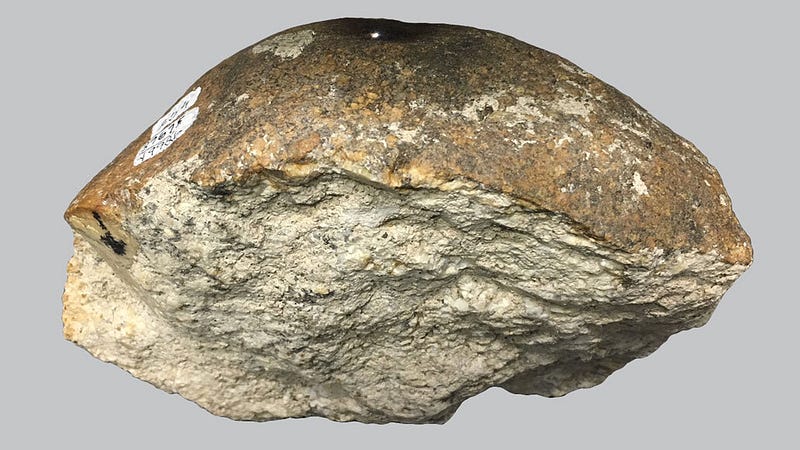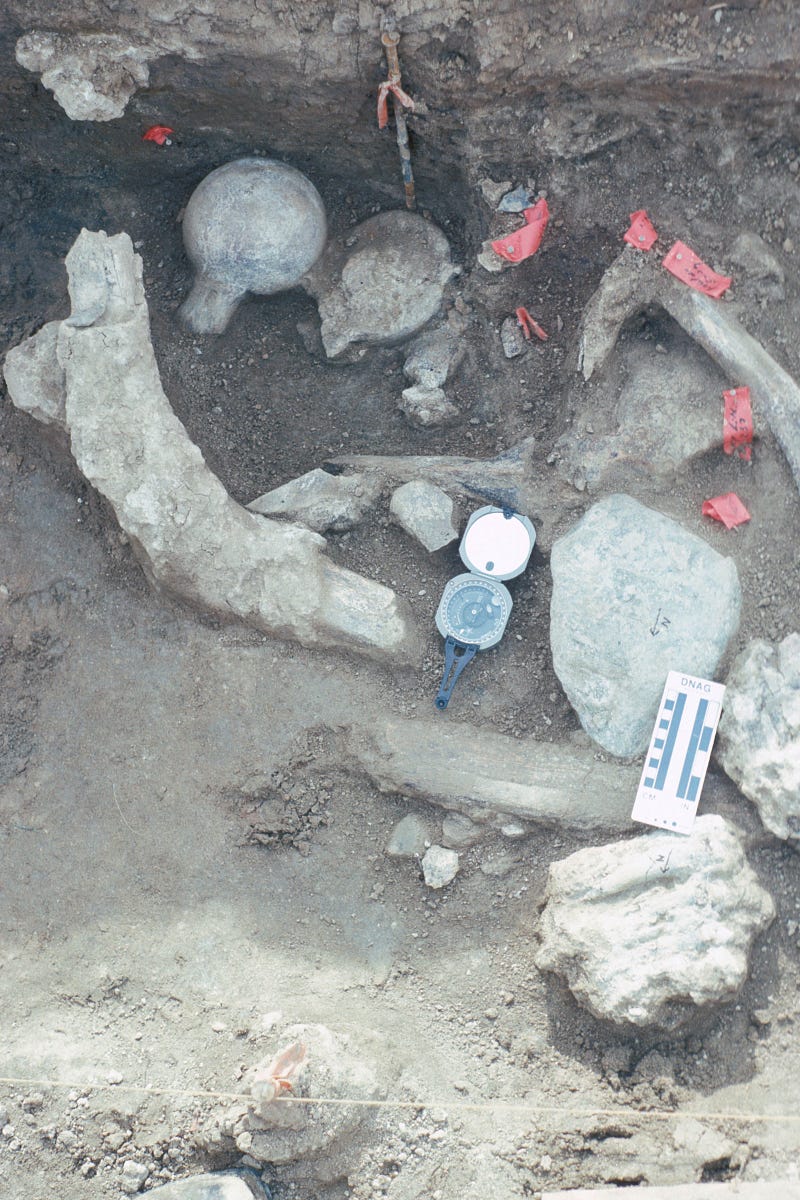Re-Learning History: New Evidence for Humans in North America 130,000 Years Ago
New Study Bolsters Cerutti Mastodon Site Findings
New Study Bolsters Cerutti Mastodon Site Findings

More proof humans were here over 130,000 years ago? Additional testing has added weight to the evidence there were human Mastodon Hunters on the West Coast of North America around 110,000 B.C., though many in archaeology and anthropology remain unconvinced. Then again, the Cerutti Mastodon Site in San Diego, California — and its dating — have been controversial since its discovery was announced just over three years ago.
What they discovered and documented are the remains left by human scavengers who picked apart a Mastodon carcass, and broke open its bones to get to the marrow. One of the mastodon’s tusks was even stuck vertically into the ground, as if to mark the spot. Bones which defy breaking by natural elements were shattered, and piled around the site. Anomalous rocks and cobblestones were present, primitive hammers used in their scavenging.
A new follow up paper in the Journal of Archaeological Science suggests there is substantial bone residue on the alleged stone tools or “cobbles” they found, and that testing proves this bone residue was not the result of incidental contact by natural means, but is instead smashed into the stones. At least one of the stone tools shows evidence it was used as a hammering device, another, that it served as the anvil upon which the bones were smashed.[i]
“Critics have suggested that the stones may have broken by rolling down slopes rather than in situ at the two concentrations. Our analysis… identifies bone micro-residues that are not evenly distributed over the cobbles, and are unlikely to have been transferred from sediment or from passive contact with adjacent macro-bones,”[ii] the team said in the new paper.
For the longest time, archaeologists and anthropologists believed modern humans came to the Americas from Asia across a land bridge in the Bering Strait around 12,000 years ago. This was called the “Clovis First” hypothesis, and it’s since been disproven — humans were in North America at least a few thousand years earlier. If you’re curious why the proposed first people were called “Clovis”, it was simply because Clovis was the name of the site where a particular projectile point had been discovered, and the culture was identified by the use of these points.
“To dispute Clovis-first by a few thousand years was controversial… But to propose a site more than 100,000 years older was professional suicide,” noted the Los Angeles Times, in their December 2017 article, Archaeology As Blood Sport: How An Ancient Mastodon Ignited Debate Over Humans’ Arrival In North America. “It would undermine the research and reputations of most archaeologists now studying the New World.”
“‘If you claim something is that old, you get blasted,’ (Richard) Cerutti said in the Times article, ‘which is why some archaeologists stopped working on sites like this. They didn’t want to get blasted’.”[iii] (Cerutti passed away last November at age 78).
When the Cerutti Mastodon Site discoveries were announced in 2017, offering a possible date of 130,000 years ago for the appearance of modern humans in the Americas, the peer-reviewed science, published in the esteemed journal, Nature, was rejected and dismissed by many. But the science was sound.
“The earliest dispersal of humans into North America is a contentious subject, and proposed early sites are required to meet the following criteria for acceptance: (1) archaeological evidence is found in a clearly defined and undisturbed geologic context; (2) age is determined by reliable radiometric dating; (3) multiple lines of evidence from interdisciplinary studies provide consistent results; and (4) unquestionable artefacts are found in primary context,” [iv] the group wrote in Nature in April of 2017.
They were revealing their findings after a year of peer review and testing. “Here we describe the Cerutti Mastodon (CM) site, an archaeological site from the early late Pleistocene epoch, where in situ hammerstones and stone anvils occur in spatio-temporal association with fragmentary remains of a single mastodon (Mammut americanum).”[v]
The Mastodon bones, tusks and fragments found dated back to 130,700 (± 9,400) years. The way the fragments were spread around suggested that the breakage occurred at the site. The spiral-fracturing pattern of the bone and molar fragments indicated the breakage occurred while the corpse was fresh, and several fragments displayed evidence of having been pounded on by the rocks found nearby. Five of the rocks found on site (“large cobbles”) showed wear and impact marks indicating they were used as hammerstones and anvils. And given they were found in sand and silt, water didn’t wash them there.
“These findings confirm the presence of an unidentified species of Homo at the CM site during the last interglacial period (MIS 5e; early late Pleistocene), indicating that humans with manual dexterity and the experiential knowledge to use hammerstones and anvils processed mastodon limb bones for marrow extraction and/or raw material for tool production… The CM site is, to our knowledge, the oldest in situ, well-documented archaeological site in North America and, as such, substantially revises the timing of arrival of Homo into the Americas.”[vi]
They were savagely attacked by their fellow academics at the time — the Times didn’t call Archaeology a “Blood Sport” for nothing. But the team has kept at it, as evidenced by team members’ involvement in the new study which shows the tools were likely tools — the evidence confirms they were used as hammers and anvils. The amount of bone residue, and the way it is smashed into the surfaces of the stones, makes natural occurrence extremely unlikely.
The new paper may not convince many who doubted the initial report, but it adds to the evidence. Some still argue the bones could have been smashed by highway truck traffic, and point out the new study didn’t find collagen on the stones, though an earlier, as yet unpublished study by one of the team did indeed discover collagen.[vii]
Still, as the evidence in favor of the Cerutti Mastodon site increases, the dating of human migration into North America may be pushed back yet again, and necessitate once again Re-learning History.
You can learn more about Clovis First being outdated, as well as more on the Cerutti Mastodon discovery, in the original Re-Learning History article.
Notes:
[i] L. Bordes et al. Raman and optical microscopy of bone micro-residues on cobbles from the Cerutti mastodon site. Journal of Archaeological Science: Reports. Vol. 34, Part B, December 2020. doi: 10.1016/j.jasrep.2020.102656
[ii] Ibid.
[iii] “Archaeology as blood sport: How an ancient mastodon ignited debate over humans’ arrival in North America”, Los Angeles Times, December 22, 2017.
[iv] “A 130,000-year-old archaeological site in southern California, USA”, Nature, April 27, 2017. https://www.nature.com/articles/nature22065.
[v] Ibid.
[vi] Ibid.
[vii] Two stones fuel debate over when America’s first settlers arrived, by Bruce Bower. ScienceNews.com, December 4, 2020. https://www.sciencenews.org/article/stones-mastodon-bones-debate-america-first-settlers.




